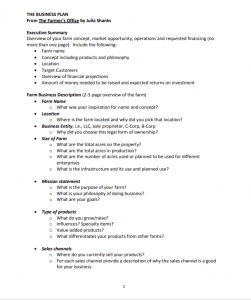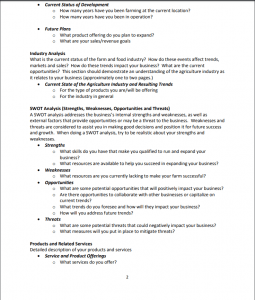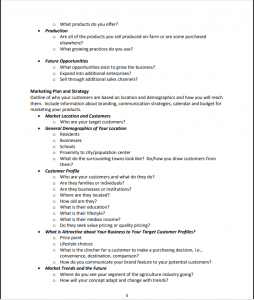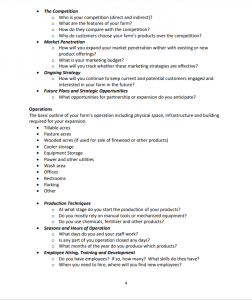When it comes to writing grants, there are a lot of great resources that you can find online. My goal for this blog post is to point you in the right direction to some of these resources that can help you with the beginning process of your grant writing.
The Business Plan
Many times a farmer has a great idea, but has not developed a business plan to determine if their idea is financially sound. Below are images of an outline for a business plan from The Farmer’s Office by Julia Shanks. It’s a great starting point for anyone interested in pursuing grant funding. (Click on the images in order to see them in a larger format)
The Grant Proposal
All of the information below can be found with more detailed descriptions on the Agricultural Marketing Resource Center’s Website: https://www.agmrc.org/business-development/starting-a-business/raising-money/articles/introduction-to-grant-writing
The Big Why
The first step in writing your proposal is to determine why you need a grant. Don’t write a grant unless you have clearly defined why you need the money. Remember grant assistance will not carry a project if it is not based on sound principles. Secondly, gather information. The information will need to come from three key areas – concept, program and expenses.
The Components of a Proposal
- Executive Summary: This is the most important page of your document. It is on this page that you provide the reader with an overall summary of your project and convince the reader that your project deserves the funding you are asking for.
- Statement of Need: Your statement of need enables your reviewers to learn more about the details of your project and the issues behind it. This section is your opportunity to present your side of the debate. Line up all your arguments and present your case logically and convincingly for the reader.
- Project Description: This section of your proposal includes the following five sections – objectives, methods, staffing, evaluation and sustainability. Your objectives, combined with your methods, will dictate your staffing needs and will then become a basis for your evaluation. Sustaining the project will come after its success and its ability to survive without a grant source. Together, the five sections give a solid picture of your entire project.
- Budget: Your budget section is dependent on your project itself. Your proposal may be as simple as a one-page statement of projected expenses, or you may have a complex document of projected support and revenue and various items of expense.
- Organization Information: You will want to include a resume for your value added ag institution and/or the staff members involved in the project. Explain why your organization came into existence, your mission, your goals and your organizational structure.
- Conclusion: It is important to leave the reader of your proposal with a good feeling about your project and sum up your need for the funding. Call attention to the future – underline some activities that you plan to begin following the funding award or state how you might continue, or not continue, without the funding support.
Ideally, if you are interested in applying for a grant, you should seek the assistance of a grant writer or someone who’s familiar with the different types of farm grants. If you are interested in learning about what grants are available to farmers, check out this previous Ag-Informer blog-Programs & Grants for Farmers: https://blogs.cornell.edu/agnewscenter/2018/12/18/programs-grants-for-farmers/
If you are interested in learning more about writing business plans and grant proposals, contact your local CCE office or myself at 518-272-4210.
Happy Writing,
-Kayela







